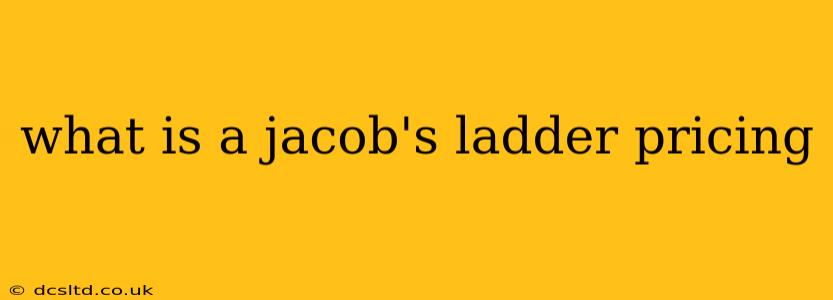Jacob's Ladder pricing, a somewhat less common but intriguing pricing strategy, involves structuring prices in a tiered system that mimics the rungs of a ladder. Each rung represents a different product or service offering, with increasingly higher prices reflecting added features, benefits, or enhanced value. Unlike simple price differentiation, Jacob's Ladder focuses on clearly showcasing the incremental value proposition at each price point. This transparency allows customers to easily compare and choose the option that best suits their needs and budget.
This strategy is particularly effective in situations where:
- There's a clear progression of value: Each level offers demonstrably more than the previous one, preventing customer dissatisfaction with a perceived lack of value for the price.
- Target markets vary in needs and budgets: Jacob's Ladder caters to a broader audience, accommodating diverse purchasing power and feature requirements.
- Upselling opportunities are desirable: The tiered structure naturally encourages customers to consider upgrading to a higher tier, increasing average order value.
How Does Jacob's Ladder Pricing Work?
The core principle of Jacob's Ladder pricing lies in creating distinct tiers, each with its own set of features and corresponding price. This clear hierarchy allows customers to easily understand the value proposition at each level. Let's illustrate with a hypothetical example:
Imagine a software company offering three tiers of its project management software:
- Basic ($29/month): Offers core project management features, limited user access, and basic reporting.
- Premium ($49/month): Includes all basic features plus advanced reporting, increased user access, and integration with other popular business tools.
- Enterprise ($99/month): Combines all premium features with dedicated customer support, customized integrations, and priority technical assistance.
This clear delineation allows customers to readily assess which tier best aligns with their needs and budget. A small business might opt for the Basic plan, while a larger enterprise might choose the Enterprise plan for its advanced capabilities and dedicated support.
What are the Benefits of Jacob's Ladder Pricing?
- Improved Customer Perception: The transparency of Jacob's Ladder pricing fosters trust, as customers clearly see what they're paying for at each level.
- Increased Sales: By offering various price points, you capture a wider customer base and potentially increase overall sales volume.
- Higher Average Order Value: The tiered system naturally lends itself to upselling; customers might initially opt for a lower tier but upgrade later as their needs evolve.
- Simplified Decision-Making: The clear hierarchy makes it easier for customers to choose the option that best fits their requirements.
What are the Drawbacks of Jacob's Ladder Pricing?
- Cannibalization: If the tiers are too close in value or features, a higher-priced tier might cannibalize sales from a lower-priced one. Careful planning and differentiation are crucial.
- Complexity: For products or services with numerous features, creating a clear and easy-to-understand tiered system can be challenging.
- Pricing Analysis: Requires thorough market research and analysis to determine optimal price points for each tier, ensuring profitability at each level.
What are some examples of Jacob's Ladder Pricing?
Many software-as-a-service (SaaS) companies use Jacob's Ladder pricing, often offering basic, premium, and enterprise plans. Subscription boxes also frequently employ this strategy, providing varying levels of product quantity or quality at different price points. Even some retail businesses use this in a more subtle way, offering different packages or bundles of products at increasing price points.
How is Jacob's Ladder Pricing different from other pricing strategies?
Jacob's Ladder pricing differs from other strategies in its focus on clear, incremental value at each price point. Unlike value-based pricing (which focuses on perceived value), Jacob's Ladder aims to demonstrate tangible differences between tiers. It contrasts with premium pricing (which emphasizes high quality and luxury) by offering a range of options at different price points, catering to diverse budgets.
Is Jacob's Ladder Pricing right for my business?
Jacob's Ladder pricing can be a very effective strategy, but its suitability depends on your specific product, target market, and business goals. Consider the following factors:
- Product complexity: Does your product or service lend itself to a tiered structure with clear feature differences?
- Target market segmentation: Do you have clearly identifiable customer segments with differing needs and budgets?
- Profitability analysis: Can you achieve profitability at each price point?
If your answer is yes to all three, then Jacob's Ladder pricing may be a viable option for your business.
By carefully considering these factors and implementing this strategy correctly, businesses can leverage Jacob's Ladder pricing to increase revenue, improve customer satisfaction, and enhance their overall market position.
